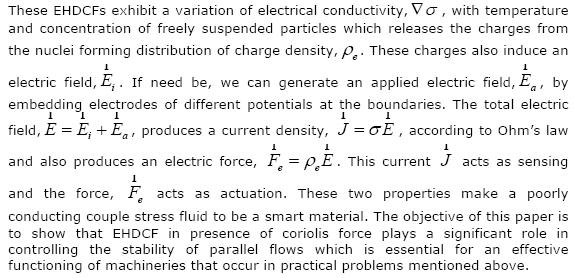EFFECTS OF ELECTRIC FIELD AND CORIOLIS FORCE ON ELECTROHYDRODYNAMIC STABILITY OF POORLY CONDUCTING COUPLE STRESS PARALLEL FLUID FLOW IN A CHANNEL
B.M. Shankar and N. Rudraiah
UGC- Centre for Advanced Studies in Fluid Mechanics, Department of Mathematics,
Central College Campus, Bangalore University, Bangalore – 560 001.
and National Research Institute for Applied Mathematics, 492/G, Jayanagar, Bangalore-560070, India
Abstract. The effective functioning of microfluidic devices in chemical, electrical and mechanical engineering involving fluidics particularly those having vibrations and petroleum products containing organic, inorganic and other microfluidics require understanding and control of stability of poorly conducting parallel fluid flows. The electrical conductivity, σ, of a poorly conducting fluidics, increases with the temperature and the concentration of freely suspended particles like RBC, WBC and so on in the blood, the hylauronic acid (HA) and nutrients of synovial fluid in synovial joints will spin producing microrotation, forming micropolar fluid of Eringen. The presence of Deuterium - Tritium (DT) in inertial fusion target (IFT) may also be modeled using micropolar fluid theory of Eringen. A particular case of micropolar fluid theory when microrotation balances with the natural vorticity of a poorly conducting fluidics in the presence of an electric field is called ‘electrohydrodynamic couple stress fluid’ (EHDCF).

A sufficient condition for stability is obtained using the nature of growth rate, ci as well as sufficiently small values of Reynolds number, Re. From this condition, we find that the strengthening or weakening of the stability of EHDCF is dictated by the strength of electric field, the coefficient of couple stress fluid and Taylor’s number. In particular, we find that the interaction of electric field with couple stress fluid is more effective in stabilizing the poorly conducting couple stress fluid compared to that in ordinary Newtonian viscous fluid.